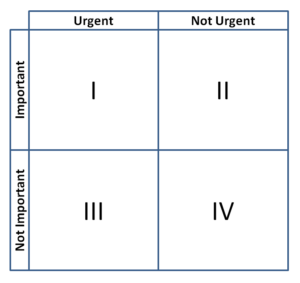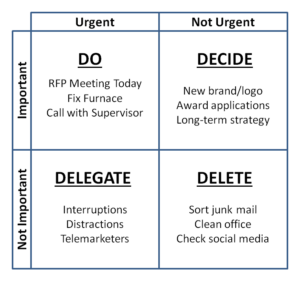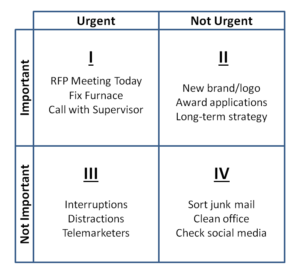Prioritizing Your Work: The 4-Square Method
Last week, our prioritization blog focused on the Hoshin Star Technique. To recap, this method allows you to compare each of your tasks head-to-head with one another in order to determine which task is the most important. To read the Hoshin Star Technique Blog post, click here.
This blog post will focus on the ‘4-Square’ method of prioritization, which is also referred to as the Eisenhower Grid. President Dwight D. Eisenhower once said, “What is important is seldom urgent and what is urgent is seldom important.” This quote is the inspiration for the Eisenhower grid, a system that helps you decide the urgency and importance of different tasks, and prioritize them accordingly.
To complete the 4-square, create a 2 X 2 grid, with the vertical axis labeled Not Important and Important, and the horizontal axis labeled Urgent and Not Urgent, as shown below.

Given your list of tasks, place each of them in the grid according to urgency and importance.For example, say your list included the following:
- Fix furnace
- Telemarketer phone call
- Award applications
- Check social media
- Create new brand/logo
- Long-term strategy
- RFP Meeting today
- Random interruptions
- Sort junk mail
- Clean office
- Distractions
Separate your list of tasks into the four categories. Once you have your tasks separated, plug them into the grid. As shown in the first figure, each square has a corresponding number, and this is the order in which you should prioritize your tasks.
The figure below shows the list of tasks separated into the 4 squares. Obviously, fixing the furnace or a call with your supervisor has higher urgency and importance than sorting junk mail or cleaning your office. As shown in the table, each square has a corresponding number, and this is the order in which you should prioritize your tasks. Focus on the most urgent and important tasks first in Square I, and then move to squares II, III and IV. This does not mean that you should not spend time on not-urgent tasks, but in a high-stress situation, this method can be important in determining what needs to be completed first.
In some situations, the Roman Numerals in the squares can be replaced by the following actions: Do, Decide, Delegate, and Delete. In this case, your tasks are still separated into the original four categories. However, the following action item changes. The tasks that are important and urgent: DO. Do them today, or as soon as possible. For tasks that are important and not urgent: DECIDE. Decide a specific time in the future that this task will be completed, as it will eventually be Important and Urgent.
For tasks that are not Important but urgent: DELEGATE. These tasks are often e-mails or phone calls that need to be answered by someone, but it doesn’t always have to be YOU. Finally, for tasks that are not important and not urgent: DELETE. These tasks are not significant or central to your business goals. Granted, these tasks can be completed during personal time, or when pressure levels are lower, but in a high-stress situation, these tasks are just not relevant.

This method of prioritization allows you to determine which of your tasks are most important and most urgent, and act accordingly. As mentioned in our previous blog, this is just one example of many different prioritization techniques. You must find the system that works best for you, and this will allow you to prioritize, create a plan of action, and execute.
Do you use any other methods to prioritize your tasks? Let us know in the comments below!
Melissa H. • April 14, 2015
Posted in these categories:
Marketing TipsWith these tags:
b2b marketing, content marketing, marketing tips, Marketing Works
